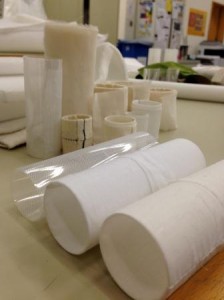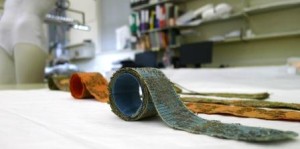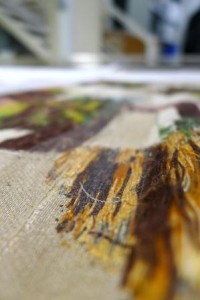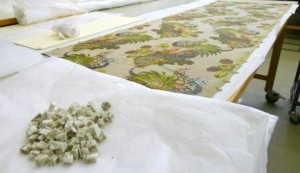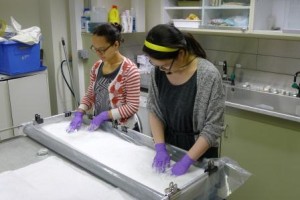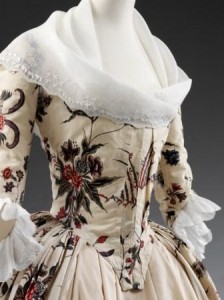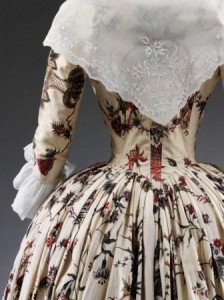
by Geraldine Sim, First year student, MPhil Textile Conservation
Between the first and second years of the MPhil Textile Conservation programme students undertake a work placement of a minimum of six weeks. I’ve been so lucky to have the opportunity to undertake mine at the Victoria and Albert Museum in London. I’m currently 8 weeks in and am thoroughly enjoying the work here…there’s still so much to learn! Under Senior Textile Conservator Elizabeth-Anne Haldane’s supervision, most of the work I have been entrusted with is for the Europe 1600-1800 galleries that are set to open next year.
Mounting
Several lengths of ribbons and lace are part of a display that is aiming to mimic a shopfront. We had to devise a mount for them that would make these short lengths of ribbons appear longer as they hung off miniature rollers. The same was required for 2 lengths of silk brocade. With plenty of advice and encouragement from Keira Miller one of the V&A’s mounting specialists, I was able to achieve just that!
Images © Victoria and Albert Museum, London.
This to…………………………………… …THIS! Yes, they work miracles here in the V&A.
Interventive work
Extensive work was to be carried out on a french silk brocade. It dates to the 17th Century and had previously been treated with both ammonia to clean the metallic threads and an adhesive coated net patch in the repair of an extensive cut that through the middle of the textile. Unfortunately, colour fastness tests conducted indicated that wet cleaning would not be viable as the darker embroidery threads either ran and/or displayed significant colour change. Instead, surface cleaning was conducted with cosmetic sponges. The removal of the previous repair was necessary as the adhesive was just impregnated within the fabric and the embroidery floats, stiffening it. The net was removed with application of an organic solvent Industrial Methylated spirit (IMS) with a soft brush to gently release it from the floats. Tidelines and adhesive residue which remained were then treated locally with IMS, using a suction table to ensure that they were contained and completely removed .
Images © Victoria and Albert Museum, London. Above: (Left) Adhered net on reverse of silk brocade. (Right) Surface cleaning with cosmetic sponges.
I am currently in the midst of dyeing some silk and fine nylon net with Lanaset dyes for a stitched support of the tear and frayed selvedges. While dyeing samples were successful, bulk dyeing of silk is proving to be a challenge. But I’ll get there…eventually! Once completed, the textile will be mounted on a roller for display. Though it wasn’t feasible to wet clean the silk brocade, I was able to help Rachael Lee, Assistant Textile Conservator, in wet cleaning a number of other objects. One of the objects cleaned was an eighteenth century Greek towel which was an interesting comparison to the silk brocade as it too had a multitude of coloured embroidery threads that had presented with both colour and fibre loss. However, as it was thought that we would be able to control and minimise any colour loss by managing the pH and duration of the wash baths, as well as expediting the drying process. Wet cleaning was undertaken and was a success: there was no visible colour change to the embroidery and a substantial amount of yellowing caused by cellulosic degradation had been removed. Another project, the wet cleaning of a fichu and ruffled cuffs, had very gratifying results.
Images © Victoria and Albert Museum, London
The cuffs and fichu after conservation
Images taken by V&A Photo Studio and © Victoria and Albert Museum, London.
And that’s not it! Below is list of other projects and events I’ve been able to get involved in during my placement here at the V&A. –
– Mounting and patch support of a Chanel Dress for the Richard Horst Exhibition
– Stitching Velcro® to a Tapestry for the Europe 1600-1800 galleries
– Helping out with photography of objects for the Europe 1600-1800 galleries
– Attending a Hair Conference at the Horniman Museum
– Cleaning of objects on open display in the Italian Fashion Exhibition
– Participation in Dress and Textile Specialists (DATS) workshop for the mounting of historic dresses
– Assessment of objects in Blythe House for an Indian Exhibition next year
– Mock up for display in Europe 1600-1800 galleries
– Analysis of a Chinese Painted Silk for the Europe Gallery using X-Ray Fluorescence (XRF)
– Visiting fellow student Cecilia Voss on her placement at Kew Gardens
– Undertaking an Interns’ tour of the V&A …and there’s still much much more to come!


